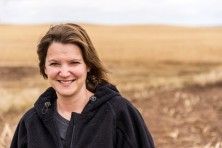Rent Paid for Soil and Water Protection
- Share
- Tweet
- Pin
- Share

New county map makes it easier for producers to find eligible land
Farmers don’t need to plant every tillable edge and corner of their fields, only to see it not produce and watch valuable soil and expensive chemicals wash into wetlands.
Instead, producers can get paid for not planting some of those less profitable, barely productive strips and corners of fields. A county conservationist said participation is decent, but a lot of eligible land doesn’t end up in the Conservation Reserve Enhancement Program (CREP): a voluntary program that pays landowners to install filter strips along waterways or to return frequently flooded fields to wetlands, while leaving the remainder of the adjacent land in agricultural production.
“Since 2017, there have been 104.8 acres reenrolled in the program and 98.58 new acres enrolled,” said Brianna Schroeder, a Door County conservationist. “After the 15-year CREP contract is up, landowners can choose to enroll the land again. Potentially 7,636 acres are eligible for CREP in Door County: 5,230 for wetland buffers and 2,406 for stream buffers.”

The program is a joint effort among federal, state and county agencies. The Door County Soil and Water Conservation Department (SWCD) resumed its promotion of CREP in 2017 and became more active about it this month by adding a new interactive map to its website at co.door.wi.gov/1113/Conservation-Reserve-Enhancement-Program that allows landowners to see whether they have land that is potentially eligible for CREP.
“In order to be eligible, it must be cropland within the townships of Union, Brussels, Forestville, Clay Banks, Gardner, Nasewaupee and Sturgeon Bay,” Schroeder said. “It also must be within 150 feet of a stream, body of water, wetland or sinkhole.”
Website users can zoom in to their land parcels to see how much can qualify for a 15-year, guaranteed, federal-government rent payment, as well as grassland, prairie or pollinator-friendly seed mixes for buffer strips and buffer zones.
Door County has fewer streams than some counties in Wisconsin, but it has plenty of wetlands and locations that drain toward lakes. Because of its fractured karst geology, there are also plenty of sinkholes. Motorists can see a lot of them if they notice circles of rock piles placed in the middle of farm fields as fill material. Often, farmers plant in a circle or small square around those low spots, only to see those spots not produce.
“If you have a field edge, you can run into low yields. With this program, you know for sure you’re going to get a paid return,” Schroeder said.
Some farmers put land under a CREP contract that’s in a small, wet corner or rectangle of field jutting into woodlands. Others use CREP to square off field edges and make straighter rows that are easier to navigate. On average, farmers who participate turn between a half acre and four acres into a buffer zone, Schroeder said.
Richard Olson of the 150-year-old Olson Family Farm, has 10 of the farm’s 1,150 acres in the CREP program. He described both locations as “very hilly” spots that are not particularly productive and subject to soil erosion. He and his brother, Eric, don’t use the land for grazing, either, because they don’t have their dairy herd on pasture.

“There’s always some edges of properties where land’s not that productive,” Olson said. “There are a lot of things it could be used for better than cropping.”
In their efforts to conserve topsoil, and coincidentally sequester some carbon, the Olsons also plant cover crops between harvests. Their favorite is a blend of turnips, radishes, clover, oats and wheat. Olson plants corn, no till, directly into the cover crop, some of it that does not winter-kill, such as the wheat and clover. During the early spring in fields that did not have cover crop, the Olsons plant clover and ryegrass between the corn rows.
Producers may contact the county’s SWCD or the Farm Service Administration to schedule a site visit to determine which land to enroll in the program. The base annual CREP rental rate paid by the U.S. Department of Agriculture (USDA) ranges from $50 to $250 per acre, depending on the county, soil type and previous land use, according to the Wisconsin Department of Agriculture, Trade and Consumer Protection. Rates can increase from the base between 35% and 60%, depending on the conservation practice installed, according to the USDA.
If a portion of land is deemed ineligible for CREP, the SWCD can talk to landowners about other conservation measures, such as the CREP Equivalent Program or the County Vegetated Buffer Program.
Learn more by calling the SWCD at 920.746.2214.


